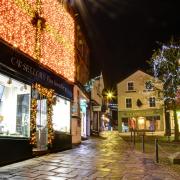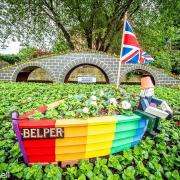Out and about with Roly Smith
You’ll soon be able to trek the trails of the Peak District without even getting your boots dirty. You’ll be able to get stunning, 360-degree views of Fin Cop and the River Wye from the Monsal Head viaduct; experience the spectacular dams and reservoirs of the Upper Derwent, or pretend to be Keira Knightley in the movie Pride and Prejudice, gazing at the famous view from Stanage Edge, without ever having to leave the comfort of your own home.
It’s all down to a new deal the National Park Authority has done with internet giants Google, to became the first UK National Park to capture some of its most iconic landscapes through Google Street View.
The National Park is borrowing free-of-charge an expensive piece of equipment known as the Google Trekker to photograph some of its most popular landscapes. The images will then be made available online on through Google Maps and Street View for anyone to enjoy virtually, from home, work, or when they are on the move.
The Google Trekker is a four-foot-high backpack, weighing 42 and a half lb and fitted with a 15-angle-lens camera, which takes 360 degree pictures every two and a half seconds. I tried out the Trekker – which looks a bit like a bright green ballroom glitterball or perforated football perched on top of an old-fashioned frame rucksack – when I went to the launch of the project, which coincided with the 63rd anniversary of the founding of the Park, on the Monsal Head viaduct.
It weighs about the same as a typical backpacking rucksack, and I found it was surprisingly light, although initially quite difficult to balance while walking, because of its top-heavy weight. I was pleased to hear that National Park staff, mainly rangers and volunteers, will receive training from Google before they use it.
Google’s programme manager for Street View, Anthony McLoughlin, explained: ‘Once you get used to it, it isn’t a problem. But you mustn’t wear a hat, because that might be picked up in the photographs.’
Peak District National Park chief executive Jim Dixon was ‘thrilled’ that the Peak was the first UK national park to get the Trekker. ‘It is amazing to think that thanks to technology, many more people will be able to enjoy the outstanding natural beauty of the Peak District,’ he enthused.
‘The Trekker will help bring the park to life online, and hopefully inspire families to come and enjoy a walk or a cycle ride in the most beautiful landscapes.’
Emily Clarke, Communications Manager for Google UK, explained: ‘With more organisations all over the world borrowing the Trekker, armchair explorers, travellers and history enthusiasts are able to view many remote and hard-to-reach places, which they may never have reached on their own.’
The acquisition of the Trekker puts the Peak in exalted company. Previous world-famous locations captured by the Google technology include Colorado’s Grand Canyon, the Angkor Wat Temples in Cambodia, the Taj Mahal in India, and a rather cloudy view of Everest Base Camp.
While I fully appreciate that this new technology is great for people who will never be able to actually visit these places, I personally still like to feel the wind and rain on my face, and the sounds and smells of the countryside as part of a total, not virtual, experience.
- On the day of the launch, Google honoured the Park’s 63rd birthday by designing a special Peak District ‘Doodle’ for its UK homepage. The Doodle showed the Park’s millstone boundary marker, with the Salt Cellar, a rock formation on Derwent Edge, at its centre.



























